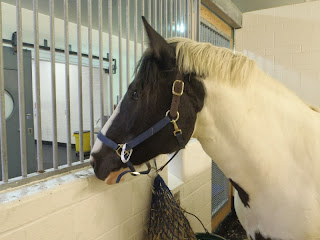Have you ever wondered what occurs during a lameness evaluation at Cornell University's College of Veterinary Medicine's Equine and Farm Animal Hospital?
If you're lucky, you have never had reason to experience it, but I know that many horse owners, and pet owners in general, are glad to have that well-known institution in the region when it comes to the expert care of our critters.
I am one who has always been curious as to what goes on there. And now I know, because Hudson and I, with friend Trish Pierce, trucked ourselves up there on Friday to see what might be making my big, black-and-white beastie show signs of pain.
 |
| Hudson wearing a patient's "wrist band" on her halter. |
If you're lucky, you have never had reason to experience it, but I know that many horse owners, and pet owners in general, are glad to have that well-known institution in the region when it comes to the expert care of our critters.
I am one who has always been curious as to what goes on there. And now I know, because Hudson and I, with friend Trish Pierce, trucked ourselves up there on Friday to see what might be making my big, black-and-white beastie show signs of pain.
Her symptoms are subtle: With regular work, she doesn't want to be ridden downhill. This issue becomes worse with work. When you "google" this, you will find every possibility under the sun -- sore back, saddle fit, sore hocks, sore stifles, sore front feet, vision, ulcers.
Yeah, right -- that's a big help!
Yeah, right -- that's a big help!
 |
| The "Big Red" hall. |
These symptoms are not intense, but I have entered Hudson in one of the Genesee Hunt Races in October and I wanted to make sure I wasn't going to be doing something that hurt her. So our trip to Cornell was a combination of a lameness exam and a soundness exam.
 |
| Dr. Fubini explains how to flex the fetlock. |
Then the great, red, sliding doors opened and we stepped into the mysterious world of Cornell Equine.
Hudson went into a large stall with shavings and water, and I hung her hay bag to keep her brain busy. We were attended to immediately and frequently by a number of veterinary students, and also met Dr. Susan Fubini, professor and section chief of large animal surgery, who would be attending to Hudson.
In short order, students checked Hudson's vital signs and tested her front hooves for pain (none was detected). Then Dr. Fubini reappeared, along with Dr. Lisa Fortier, whose focus is on bones and joints, and a group of students. Hudson's joints were flexed and held, and then she was trotted down Cornell's long, well-padded, red hallway. No significant pain was detected.
 |
| Trotting on black top. |
Nope, nothing. So we saddled her up and I rode. She took some short steps on sharp turns, but nothing Dr. Fubini said she would even call out in a pre-purchase exam.
 |
| On the lunge line with spectators. |
Next came peanut butter and jelly sandwiches for Trish and I, and X-rays of the front hooves, for Hudson.
Dr. Fortier called us in to review them. Her main points were that Hudson's hooves are beautifully balanced and her coffin and navicular bones are perfect. She said my 10-year-old heavy girl has the hooves of a 2-year-old! Also, she has tons of sole -- nothing thin about them. The only spot of concern was a touch of arthritis starting in the upper pastern joint, and she recommended I take off a bit more toe during trims. She said the arthritis is nothing to worry about now, but getting some of the weight off my favorite fatty was definitely prescribed.
The fact that she was the first person to tell me that Hudson is too fat was a surprise to both Trish and I. Usually vets tell me that from the moment they see her. It's a constant problem that I'm not always as diligent in fighting as I should be.
 |
| Dr. Fubini helps tack up. |
 |
| Feeling like I'm in the Spanish Riding School (on my fat, piebald Lipizzaner?) |
A check of the stifles was the last part of our visit. They were proclaimed tight, which is good.
Overall, they detected a mild lameness on a few steps and the start of arthritis in her pastern.
There was nothing left to do now but pay the bill and go home.
The payment part is what everybody worries about at Cornell, but I was very relived to see that the full cost was just over $400, and most of that was the cost of X-rays. The actual exams were quite inexpensive, especially considering I had a section chief, an orthopedic specialist and the head farrier all examine her, not to mention a plethora of vet students.
There was nothing left to do now but pay the bill and go home.
 |
| Good shot from the viewing area. |
 |
| Mr. Kruas evaluating her hooves. |
 |
| It's hard to get a shot of a farrier's face! |
I was delighted with Hudson's behavior. If she was questioning what the heck we were doing there, she never let it show. She just played along, cooperating gamely with every step of the process.
 |
| Leaving through the big red doors. |
Cornell's service and people were great, and I have nothing but good to say about our experience. And a big THANKS to Trish for being my wingman!





She really was a spectacularly well-behaved (and universally-loved!) horse. Everyone commented on how cute she is, which is, of course, true, but more than that, she was patient and gentle, cooperative and friendly. No one could ask for a better patient! Easy to fly wingman on that sortie!
ReplyDelete